
Dili is the capital and largest city of East Timor. It lies on the northern coast of the island of Timor, in a small area of flat land hemmed in by mountains. The climate is tropical, with distinct wet and dry seasons. The city has served as the economic hub and chief port of what is now East Timor since its designation as the capital of Portuguese Timor in 1769. It also serves as the capital of the Dili Municipality, which includes some rural subdivisions in addition to the urban ones which make up the city itself. Dili's growing population is relatively youthful, being mostly of working age. The local language is Tetum, however residents include many internal migrants from other areas of the country.

Politics of East Timor takes place in a framework of a unitary semi-presidential representative democratic republic, whereby the Prime Minister of East Timor is the head of government and the President of East Timor exercises the functions of head of state. East Timor has a multi-party system. Executive power is exercised by the president and the government. Legislative power is vested in both the government and the National Parliament. The Judiciary is independent of the executive and the legislature. The East Timorese constitution was modelled on that of Portugal, though the president is less powerful than the Portuguese counterpart. The country is still in the process of building its administration and governmental institutions. The Economist Intelligence Unit rated East Timor a "flawed democracy" in 2019.
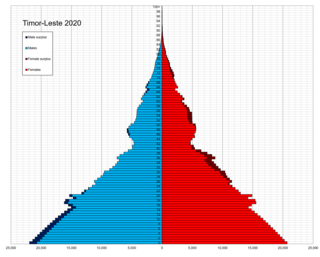
This article is about the demographic features of the population of East Timor, including population density, ethnicity, education level, health of the populace, economic status, religious affiliations and other aspects of the population.

The languages of East Timor include both Austronesian and Papuan languages. The lingua franca and national language of East Timor is Tetum, an Austronesian language influenced by Portuguese, with which it has equal status as an official language. The language of the Ocussi exclave is Uab Meto (Dawan). Fataluku is a Papuan language widely used in the eastern part of the country. Both Portuguese and Tetum have official recognition under the Constitution of East Timor, as do other indigenous languages, including: Bekais, Bunak, Galoli, Habun, Idalaka, Kawaimina, Kemak, Lovaia, Makalero, Makasae, Mambai, Tokodede and Wetarese.

Francisco Xavier do Amaral was an East Timorese politician. A founder of the Frente Revolucionária de Timor Leste Independente (Fretilin), Amaral was sworn in as the first President of East Timor when the country, then a Portuguese colony, made a unilateral declaration of independence on 28 November 1975. He was a member of the National Parliament for the Timorese Social Democratic Association from 2001 until his death in 2012. Amaral was also known as "Abo (Grandfather) Xavier", a term of endearment, by East Timorese.

Aileu is a municipality, and was formerly a district, of East Timor. It has a population of 48,554 and an area of 737 km². The municipality's capital is also named Aileu. Its administrative posts are Aileu, Laulara, Lequidoe and Remexio.
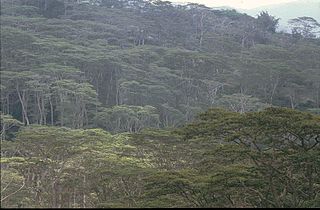
Ermera is one of the municipalities of East Timor, located in the west-central part of the country. It has a population of 117,064 and an area of 746 km².

Ainaro is one of 13 municipalities of East Timor, in the southwest part of the country. It has a population of 59,175 and an area of 804 km². Its capital is the city of Ainaro, a small mountain town.
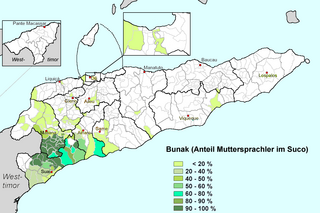
The Bunak language is the language of the Bunak people of the mountainous region of central Timor, split between the political boundary between West Timor, Indonesia, particularly in Lamaknen District and East Timor. It is one of the few on Timor which is not an Austronesian language, but rather a Papuan language, presumably belonging to the Trans–New Guinea language family. The language is surrounded by Malayo-Polynesian languages, like Uab Meto and Tetum.

The Bunak people are an ethnic group that live in the mountainous region of central Timor, split between the political boundary between West Timor, Indonesia, particularly in Lamaknen District and East Timor. Their language is one of those on Timor which is not an Austronesian language, but rather a Papuan language, belonging to the Trans–New Guinea linguistic family. They are surrounded by groups which speak Malayo-Polynesian languages, like the Atoni and the Tetum.

The Kemak people are an ethnic group numbering 80,000 in north-central Timor island. They primarily live in the district of Bobonaro, East Timor, while the rest live in the East Nusa Tenggara province of Indonesia.

The National Council of Maubere Resistance was an umbrella organisation of East Timorese individuals and organisations dedicated to resisting the Indonesian occupation of 1975–1999.
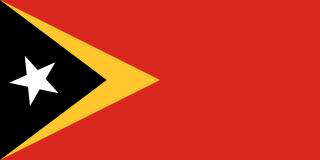
East Timor or Timor-Leste, officially the Democratic Republic of Timor-Leste, is an island country in Southeast Asia. It comprises the eastern half of the island of Timor, the nearby islands of Atauro and Jaco, and Oecusse, an exclave on the northwestern side of the island surrounded by Indonesian West Timor. Australia is the country's southern neighbour, separated by the Timor Sea. The country's size is 15,007 square kilometres (5,794 sq mi). Dili is its capital.

Norberto do Amaral is the Bishop of Diocese of Maliana, East Timor. After attending the elementary Catholic school in Ainaro, he entered the Seminary of Our Lady of Fatima in Dare. He completed his philosophical studies from 1981–1983 and theological studies between 1985–1988 at the Major Seminary of St. Peter in Ritapiret, Flores, Indonesia. He also carried out a year of pastoral ministry in the parish of Ossú during 1984. He was ordained a priest on 18 October 1988 for the Roman Catholic Diocese of Díli.

Tutuala is a village and suco in the subdistrict of Tutuala. It is situated at the extreme eastern end of Timor. Its population at the 2004 census was 3,707. The subdistrict of Tutuala comprises two sucos, including Mehara and Tutuala with the subdistrict administrator residing in Tutuala. The suco of Tutuala comprised four hamlets (aldeia): Ioro, Pitileti, Tchailoro, and Vero. The main Fataluku language areas of the country are in Tutuala, as well as Lautem and Fuiloro.
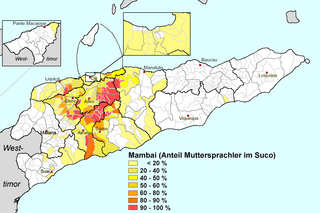
Mambai language is spoken by the second largest ethnic group in East Timor, the Mambai people. The language is also called Mambae or Manbae.
James Joseph Fox is an American anthropologist and historian of Indonesia.
Rosária Maria Corte-Real was the Minister of Education and Culture in East Timor from 2006 to 2007. She was also responsible for youth and sports. She is a member of FRETILIN.

Dionísio da Costa Babo Soares is an East Timorese politician, and a member of the National Congress for Timorese Reconstruction (CNRT). From June 2018 to May 2020, he was the Minister for Foreign Affairs and Cooperation, under the VIII Constitutional Government of East Timor; he had earlier served as Minister of State, Coordinator of State Administration Affairs and Justice, Minister of State Administration, and Minister of Justice.


















